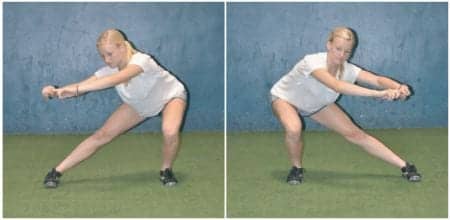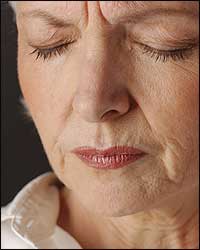
Static and dynamic stretching maximizes muscle elasticity and joint mobility, and proprioceptively prepares the athlete. Stretches, such as the “hula” shown above, are functional, full body, and tri-planar and simulate movement of actual competition.
Being a physical therapist for more than 15 years in the orthopedic setting, I have seen firsthand the alarming incidence of ACL injuries. Seventy percent of ACL injuries are noncontact injuries and typically occur when a subject is decelerating, pivoting, or landing. The rate of ACL tears is increasing for both males and females with females at a higher risk than males. A number of risk factors contribute to ACL tears, which have been classified as either extrinsic or intrinsic. Intrinsic factors (from within the body) include age, gender, strength, flexibility, joint geometry, joint laxity, anatomical alignment, and hormones. Extrinsic factors (variables that affect the athlete from the outside) include playing surface, sports equipment, taping or bracing, and weather conditions. The risk of ACL tears is particularly high for the adolescent age group (ages 14 years to 18 years).
As a father of two active children involved in multiple sports (soccer, basketball, and volleyball), I have a real concern about the risk of an ACL injury occurring sometime in their athletic advancement. The one factor within my control to help decrease this risk is through promoting a sound injury prevention program.
A well-designed ACL injury prevention program should address issues of mobility, coordination, balance, strength, power, and reactive ability. The ability of athletes to control their center of gravity while moving at high velocities is imperative for success in any sport. They need to be able to accept forces imposed on them, control the motions that are placed on the body, and create the appropriate reactions. The program should place the athletes in the three stance positions (square, split, single leg) in which they will eventually find themselves on the field or court. In other words, they are squatting, lunging, balancing, reaching, pressing, hopping, and reacting to verbal and visual cues.
A set of functional variables is an important requirement for success in any training program, whether you are training for sports performance or for injury prevention. The basic criterion in developing a functional strength program is to place the athlete in a realistic environment. This means the athlete needs to:
1. Train against gravity, controlling the body and momentum;
2. Utilize all three planes of motion; and 3. Utilize multiple muscles and joints.
The exercises prescribed should mimic the natural patterns we utilize to carry out everyday tasks. In other words, train with movement patterns specific to how we move in real life rather than only training individual muscles. The program should incorporate a specific progression of exercises through which the athlete can only progress based on technique, performance, and symptoms.
Components of an ACL injury prevention program are as follows: flexibility/mobility, stability and balance, strength, plyometrics, and agility.
FLEXIBILITY/MOBILITY
Flexibility provides a safeguard against injury in every sport, which is why it is an integral part of the training program. Stretching gradually lengthens muscles and increases laxity of tendons in preparation for exercise or sport. The program should combine static and dynamic stretching in order to maximize muscle elasticity and joint mobility, and to proprioceptively prepare the athlete for the training session. The stretches are functional, full body, and tri-planar, and simulate movement of actual competition.
The exercises should be performed with light weights to prepare the body for higher level activities. The focus is range of motion.
STABILITY AND BALANCE
“What is stability?” One would tend to think of a stable joint as one that has very little motion; however, it is quite the opposite when discussing movement patterns. Improved stability would mean being able to move the body’s center of gravity (COG) further outside the base of support with the ability to return to an upright, balanced position. The increased excursion of the COG requires all joints involved (ankles, knees, hips, and lumbar spine) to go through greater ranges of motion; therefore, stability is really a combination of coordination, mobility, strength, and balance.
There appears to be a misconception of balance. Most patients when asked to demonstrate their balance will automatically stand on one leg and attempt to stand perfectly still. That is definitely a form of balance; however, functional balance is not static, but dynamic. Balance is the ability to remain upright and react when the COG is constantly moving.
The goal for the stability/balance exercises is to reach out as far as possible without putting the opposite foot down, and then return to an upright, balanced position.
STRENGTH
Strength is an important component in injury prevention and sports performance training. In order to meet the demands of athletic tasks, athletes need a basis of functional lower extremity and trunk strength to control their COG in both vertical and horizontal directions. The absence of strength results in poor performance and poor body control, which can lead to injury. Strength exercises should be performed in all three stance positions: single leg, square stance, and staggered or split stance incorporating upper extremity movements to get different reactions in the ankles, knees, and hips.
These exercises are full body movements with emphasis on the lower extremities. The different upper body and trunk motions put various muscle groups in the lower extremity in a position of either a mechanical advantage or a disadvantage (ie, more glute involvement when the hip is internally rotated and vice-versa).
PAIN MANAGEMENT FOR SPORTS INJURIES
Implementing pain management techniques for sports-related injuries can be approached in a variety of different ways. At CATZ Physical Therapy Institute, Pasadena, Calif, Amado “AG” Garcia, PT, CSCS, utilizes a range of modalities to manage pain. This includes ultrasound, cold laser, electrical stimulation, iontophoresis, kinesiotape, heat in the form of hot packs, and ice in the form of ice packs or vasocompression ice packs.
The techniques involved in pain management differ according to the patient’s age. For example, Garcia says not all modalities can be used on children and youth, who are still developing and growing. When the use of certain modalities over children’s growth plates is not desirable, Garcia instead has young athletes warm up on a stationary bike. Garcia also recommends using cold laser therapy as an option for pain management if other modalities pose age-related problems.
Athletes can also implement pain management techniques at home using a program encompassing the use of heat, ice, and kinesiotape. Garcia provides home exercise programs for his patients, which include a comprehensive stretching- and movement-based exercise routine. When appropriate, Garcia teaches patients how to tape themselves with kinesiotape.
Three of the most prominent sports injuries Garcia sees that require pain management are knee ligament and/or meniscus injuries, low back pain, and shoulder strains and sprains.
PLYOMETRICS
Plyometric training is a very important mode of exercise for injury prevention given that most ACL tears occur when the athlete is landing, jumping, and performing rapid changes of direction. Because of the rapid deceleration followed by a rapid acceleration that is required in plyometric training, it is extremely important that the athlete possess an appropriate base of strength with good jumping and landing mechanics. Proper landing should reinforce a soft and quiet landing and absorbing the athlete’s body weight by loading in flexion in the ankles, knees, and hips.
Because of the intense movements used in plyometrics, low intensity variations should be used initially and then progress to higher intensity work (ie, limit height of jumps; soft, quiet landing with a pause between jumps; and for advanced athletes, quick explosive repetitive jumps spending as little time as possible on the ground).
AGILITY
Agility is the ability to successfully perform multiple changes of direction at high velocities. During competition, the athlete is constantly required to decelerate and accelerate in order to go from one direction to another. Often, the athlete is placed in an environment that requires changes in velocity and direction determined by an external stimulus (ie, the opposing player and/or the ball).
The progression of agility exercises begins with learning the patterns: first slow to fast, then eventually reactive: visual cueing, verbal cueing, and mirroring. Strength is a key component in successfully training the athlete to be powerful and explosive when involved in sports that require a tremendous amount of agility.
Another characteristic of a well-designed ACL injury prevention program should be that the program is safe for any age or fitness level. Progression should be based on successful performance, meaning athletes should never be put in a situation they can’t control, or be asked to do an exercise or movement they are not physically prepared to do. Safety should be the number one priority with this training approach.
Amado “AG” Garcia, PT, CSCS, has been involved in rehabilitation and sports performance training for 16 years. He is currently the Director of Programs at CATZ Physical Therapy Institute, Pasadena, Calif, where he is involved in training, education, and product/program development. Clinically, Garcia has rehabilitated a number of athletes ranging from the high school level to the professional/elite level, including Oscar De La Hoya and players from Major League Soccer and Major League Baseball. For more information contact .





